Bog Garden
Our Bog Garden bridge makes it possible for guests to walk above this unique area.
Overview of Bog Garden
A bog is commonly thought to consist of muddy, organic-rich soil. This indeed was the type of soil that was used to create our Bog Garden in the Creation Museum’s Botanical Gardens. Our bog is approximately three feet deep and was filled with peat from the bottom of a local lake and mixed with sand to give it enough structure to stand on. Many plants in this type of environment are called marginals: not in the deep water of a lake and not on completely dry land, but somewhere in between. As part of our trail system, our Bog Garden bridge makes it possible for guests to walk above this unique, verdant area with a view of the river birches, weeping junipers, and thousands of perennials.

Coronation Gold Yarrow
Common Name: Coronation Gold Yarrow
Botanical Name: Achillea filipendulina
Height: 2–3 feet
Spread: 1.5–2 feet
Location: Full sun
Bloom: June–September, yellow flower
Hardiness zone 3–9
Named for Queen Elizabeth’s coronation, this plant is a vigorous grower in most soil types and is drought tolerant. The bright yellow flowers come in masses from late spring to late summer and require full sun exposure. This non-seed-bearing variety will stay where you plant it.

Variegated Sweet Flag
Common Name: Variegated Sweet Flag
Botanical Name: Acorus calamus variegatus
Height: 2–3 feet
Spread: 1.5–2 feet
Location: Full sun to part shade
Bloom: Late spring; green flower, not showy
Hardiness zone 4–10
This plant is very easy to grow but can become invasive in boggy soil conditions. When placing in the landscape, the variegated leaf stands tall and makes a great contrast or accent in a water garden or any area with an adequate water supply. The name “sweet flag” derives from the practice of hanging the leaf “flag” and bruising it, which causes it to expel a sweet aroma. Calamus is mentioned in the Bible in Ezekiel 27:19, and a few other places as well.

Low Scape Mound Chokeberry
Common Name: Low Scape Mound Chokeberry
Botanical Name: Aronia melanocarpa
Height: 1–2 feet
Spread: 1–2 feet
Location: Full sun to part shade
Bloom: Mid-spring, white flower
Hardiness zone 3–8
This is a dependable four-season shrub with an upright, mounded growth habit. It will colonize if the new suckering growth is not removed at the base of the plant. There are small, white flowers followed by glossy, black fruit in the spring. The leaves are dark green, turning a red-purple in the fall. We planted ours in a spot that is a little wet, and they are doing fine.

Heritage River Birch
Common Name: Heritage River Birch
Botanical Name: Betula nigra
Height: 40–70 feet
Spread: 40–60 feet
Location: Full sun to part shade
Bloom: April–May, brown and green catkins
Hardiness zone 4–9
The Heritage series of birch tree can be used as a single specimen, in a hedgerow, or in a grove like we have in the back of the Bog Garden. This tree works great with most styles of architecture, so it should fit well into your landscape. The light, peeling bark will give you year-round interest, which makes this a popular four-season plant.
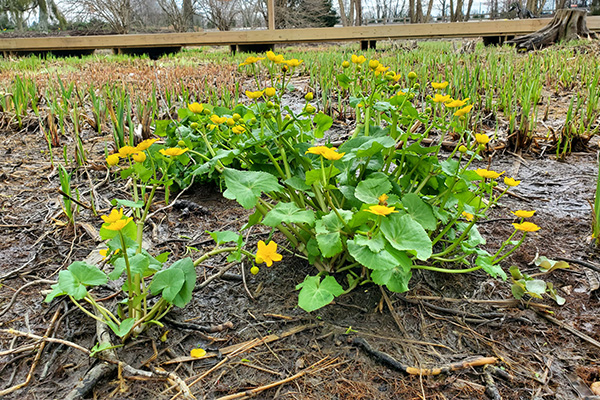
Plena Marsh Marigold
Common Name: Plena Marsh Marigold
Botanical Name: Caltha palustris
Height: 6–12 in.
Spread: 12–18 in.
Location: Full sun to part shade
Bloom: April to late June, yellow flower
Hardiness zone 3–7
As the name suggests, marsh marigold plants like to grow in wet places, so they fit perfectly in our Bog Garden. Marsh marigold is a perennial herb that emerges early in the spring season with blooming yellow flowers around mid-April. With the early and longer bloom time, this plant is both a sign of the onset of spring and a great transition plant into the spring season.
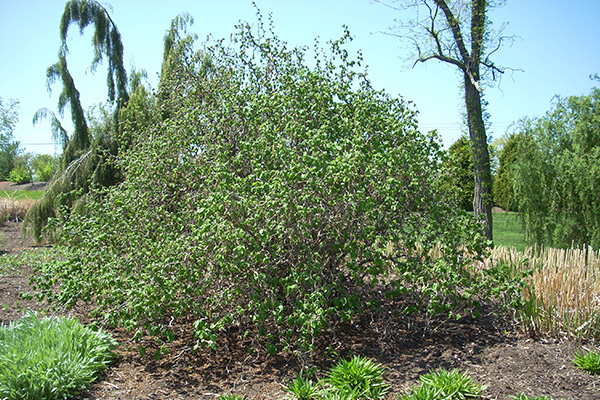
Harry Lauder’s Walking Stick
Common Name: Harry Lauder’s Walking Stick
Botanical Name: Corylus avellana contorta
Height: 8–10 feet
Spread: 8–10 feet
Location: Full sun to part shade
Bloom: March–April, greenish-yellow catkins
Hardiness zone 3–9
The unusual growth habit of this plant draws a lot of attention. We like to mention the contorted branches, which helps guests remember the botanical name. There’s much in the way of winter interest, so keep that in mind while deciding on a planting location in your landscape. This plant could easily be used as a feature plant or focal point, and it could also be used as a natural hedgerow giving separation and privacy.

Winter King Hawthorn
Common Name: Winter King Hawthorn
Botanical Name: Crataegus viridis
Height: 25–35 feet
Spread: 25–35 feet
Location: Full sun
Bloom: May, white flower
Hardiness zone 4–7
This is considered the most durable, popular, and disease-resistant variety of hawthorn. Fungal rust is an occasional problem with this plant, as with all hawthorns. This is an abundant bloomer in the spring, and it has a ton of winter interest. Although this hawthorn is easy to grow, be aware of the thorns and select a spot just away from reaching hands.

Galaxy Hardy Hibiscus
Common Name: Galaxy Hardy Hibiscus
Botanical Name: Hibiscus moscheutos
Height: 4–6 feet
Spread: 2–3 feet
Location: Full to partial sun
Bloom: July–September, pink-and-white flower with red center
Hardiness zone 5–10
This visually is a high impact perennial plant with its plate-size flowers and beautiful colors. When they are in full bloom, most guests are drawn to the flowers. They are easy to grow but do require a more-than-average amount of water to keep the soil from drying out. We cut ours all the way back every year, and they come back bigger and better.

Blues Festival St. John’s Wort
Common Name: Blues Festival St. John’s Wort
Botanical Name: Hypericum kalmianum
Height: 2–3 feet
Spread: 2–3 feet
Location: Full sun to part shade
Bloom: July–August, yellow flower
Hardiness zone 4–7
A suggested use for this plant is as a hedge or border, which is fine though they look stellar as individuals in our Bog Garden. The bright-yellow flowers are hard to miss during their long bloom time and really show off the blue-green stem. This is typically a very durable plant, and you may want to put it on the list for your garden.

Caesar’s Brother Siberian Iris
Common Name: Caesar’s Brother Siberian Iris
Botanical Name: Iris sibirica
Height: 3–4 feet
Spread: 1–2 feet
Location: Full sun to part shade
Bloom: May, purple flower
Hardiness zone 3–8
Iris is an easy-to-grow aquatic marginal, but it can become invasive if not cared for properly. We have this plant in several gardens, and it always performs well under various conditions. The dark-purple bloom is a showstopper and contrasts nicely with many other colors.
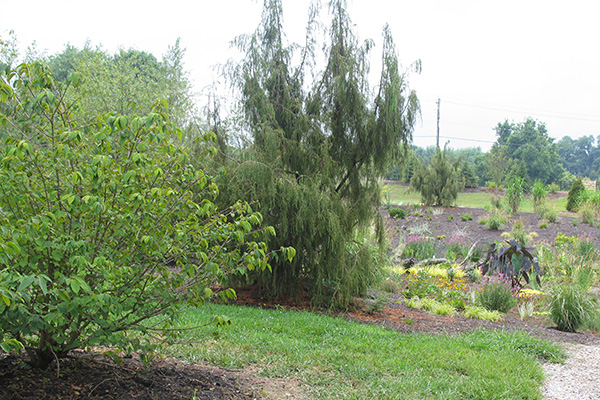
Weeping Temple Juniper
Common Name: Weeping Temple Juniper
Botanical Name: Juniperus rigida pendula
Height: 20–30 feet
Spread: 10–12 feet
Location: Full sun
Bloom: Non-flowering
Hardiness zone 5–8
This weeping juniper has an exotic look that adds an exciting element to any garden. Junipers are evergreen plants, meaning that they will hold their needles year-round. This is a “hands-off” plant requiring very little attention throughout the year. This could be a great backdrop or a feature plant in your landscape or garden.
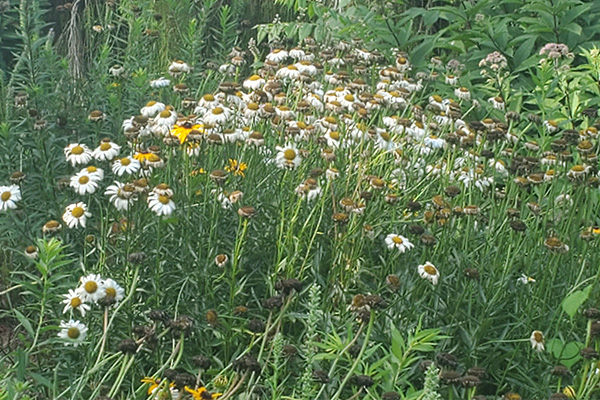
Snowcap Shasta Daisy
Common Name: Snowcap Shasta Daisy
Botanical Name: Leucanthemum superbum
Height: 1–2 feet
Spread: 1 feet
Location: Full sun, partial shade
Bloom: All summer, white flower
Hardiness zone 5–9
This is an easy-to-grow plant and one of the most popular varieties of Daisy available. It produces abundant flowers and will rebloom all summer if dead-headed. It is also listed as deer- and rabbit-resistant if you have that concern. They are great used as a border plant or in drifts, as we have them in our Bog Garden.

Morden’s Pink Loosestrife
Common Name: Morden’s Pink Loosestrife
Botanical Name: Lythrum virgatum
Height: 3–4 feet
Spread: 2–3 feet
Location: Full sun, part shade
Bloom: All summer, pink flower
Hardiness zone 3–9
Most Lythrum varieties are invasive and can produce millions of small seeds per season. The seeds are small enough to move around on water, stick to an animal, or be translocated unknowingly by a human. They can easily take over, so it is important to understand what you are planting to care for it properly. Thankfully, our variety, “Morden’s,” is sterile, so we do not need to worry about the invasive characteristics. This is a spectacular plant in full bloom and a vigorous grower. It has beautiful, long, pink flower spikes that you can enjoy all summer.
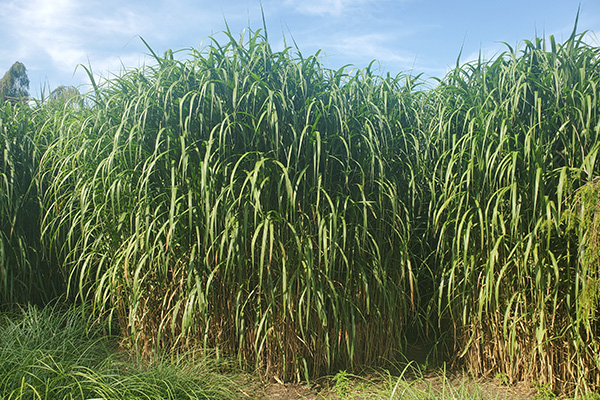
Giant Chinese Silver Grass
Common Name: Giant Chinese Silver Grass
Botanical Name: Miscanthus giganteus
Height: 10–12 feet
Spread: Clump
Location: Full sun
Bloom: September to frost; soft, pink plumes
Hardiness zone 4–9
The name for this is accurate. It is a giant grass and requires little to no care, other than the annual clean up. When choosing a spot for this, keep in mind that the diameter of the base increases annually, though you can easily dig and split them if they get too big. We use ours as a separation plant or a wall from one area to another, and it could also be used for a seasonal screen in your landscape or garden.

Quaking Aspen
Common Name: Quaking Aspen
Botanical Name: Populus tremuloides
Height: 20–50 feet
Spread: 10–30 feet
Location: Full sun
Bloom: April, insignificant
Hardiness zone 1–6
Tremuloides! How fun is that?! The leaf trembles in the wind making the quaking sound in the quaking aspen name. In nature, aspens grow in groves with a complex network of roots connecting them. Some large, old groves could all be from an original single stem. The white bark is bold with dark green leaves that turn a beautiful yellow in the fall. If you prefer a single aspen, it is possible but will take a little more care due to its spreading nature.
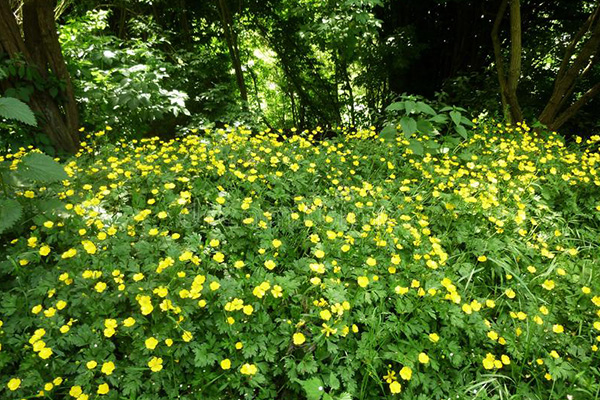
Golden Creeping Buttercup
Common Name: Golden Creeping Buttercup
Botanical Name: Ranunculus repens
Height: 1 feet
Spread: 2–3 feet
Location: Full sun to part shade
Bloom: May–August, yellow flower
Hardiness zone 4–9
This is a spreading plant that has naturalized in the US over the years. It has no serious disease or insect problems but does get powdery mildew occasionally. This is an easy-to-grow plant that adds a lovely yellow flower to your garden through the summer as a groundcover. Just keep an eye on its spread and prune as needed.

Black-Eyed Susan
Common Name: Black-Eyed Susan
Botanical Name: Rudebeckia fulgida
Height: 2–3 feet
Spread: 2–2.5 feet
Location: Full sun
Bloom:June–October, gold-yellow flower
Hardiness zone 3–9
A proven and consistent workhorse of any garden, this is an easy pick. They produce masses of gold-yellow flowers through most of the summer. They spread and colonize with their rhizomatous root system. You will only need a few in your garden to give you a mass of flowers as they mature.

Scarlet Curls Corkscrew Willow
Common Name: Scarlet Curls Corkscrew Willow
Botanical Name: Salix matsudana alba
Height: 25–30 feet
Spread: 15–20 ft
Location: Full sun
Bloom: Early spring, yellow-green catkins
Hardiness zone 4–8
It can be hard to believe that the willows you see in our Bog Garden started in three-gallon pots in 2006. These are vigorous growers that give an abundance of appeal with their twisted growth habits. They do put out suckers and send off shoots at the base that require pruning on a semi-seasonal basis. They can be planted in groves like we have in our Bog Garden or as a single specimen in your garden.
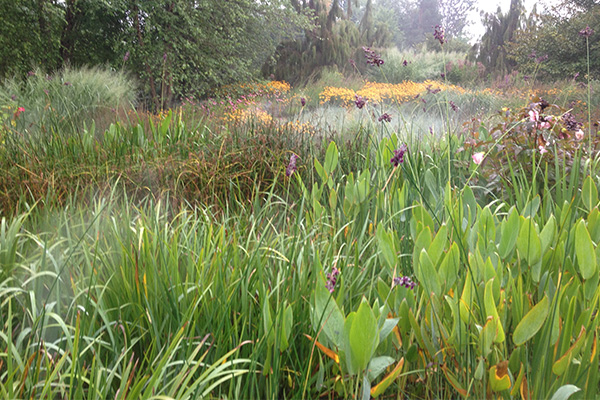
Thalia
Common Name: Thalia
Botanical Name: Thalia dealbata
Height: 6–10 feet
Spread: 3–6 feet
Location: Full sun
Bloom:All summer, purple flower
Hardiness zone 6–10
Also known as water canna, this is a bold, tropical-looking plant. It is in the marginal aquatic category of perennial plants, so it either needs to be planted on the edge of a water source or in a very wet area for its survival. Thalia forms a dramatic clump of blue-green leaves that have a white powder on them. Some call this plant “powdery alligator-flag” because of its characteristics. It has panicles of small, purple flowers that appear most of the summer on long slender stems well above the foliage.
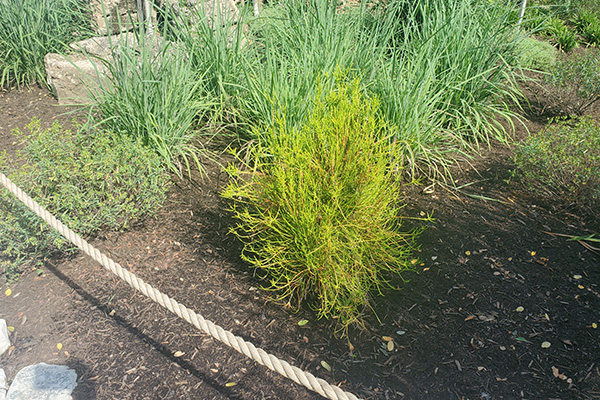
Franky Boy Whipcord Arborvitae
Common Name: Franky Boy Whipcord Arborvitae
Botanical Name: Thuja orientalis
Height: 3–6 feet
Spread: 3 feet
Location: Full sun, partial shade
Bloom: Insignificant
Hardiness zone 5–9
What an attractive plant! The color is golden in the summer, turning bronze-orange in the winter. This thread-leaf arborvitae can grow three to four inches a year and stay in a teardrop shape. All new growth is golden, which flows over the old and creates a cascade effect.